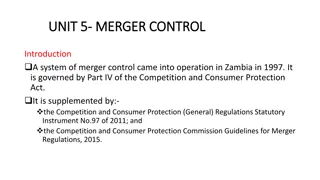Marketing SWOT Analysis for Merger and Acquisition Strategies
This SWOT analysis delves into the impact of merging resources and brands on market position and competitiveness. Strengths include brand synergy and expanded customer base, while weaknesses encompass brand integration challenges and cultural clashes. Opportunities involve accessing new markets and enhancing product offerings, whereas threats include customer overlap and distractions from core activities.
Download Presentation

Please find below an Image/Link to download the presentation.
The content on the website is provided AS IS for your information and personal use only. It may not be sold, licensed, or shared on other websites without obtaining consent from the author. Download presentation by click this link. If you encounter any issues during the download, it is possible that the publisher has removed the file from their server.
E N D
Presentation Transcript
Merger and Acquisition SWOT Analysis Example This Merger and Acquisition from a Marketing Perspective Example analysis explores how combining resources and brands could affect market position and competitive edge. To conduct a SWOT analysis for marketing, first identify your business s strengths and weaknesses. Then, explore external opportunities and threats in the market. Analyze this information to plan marketing strategies that leverage strengths, address weaknesses, seize opportunities, and mitigate threats.
ANALYSIS GOAL Evaluate the implications of a merger or acquisition from a marketing standpoint. This analysis explores how combining resources and brands could affect market position and competitive edge. SWOT ANALYSIS
STRENGTHS internal factors Brand Synergy: We can leverage complementary brand values and reputations to strengthen market presence. Expanded Customer Base: We gain immediate access to a broader customer base, enhancing market penetration and cross-selling opportunities. Combined Marketing Expertise: Merging marketing teams can consolidate expertise, leading to more innovative and effective campaigns. Increased Market Share: We can secure a larger share of the market, improving our competitive positioning. Economies of Scale: We can achieve economies of scale in marketing operations, reducing costs per unit of marketing output. Diverse Marketing Channels: Access to new marketing channels can diversify our promotional activities and reach. Enhanced Digital Capabilities: Acquisition can bring in advanced digital marketing technologies and capabilities. SWOT ANALYSIS
WEAKNESSES internal factors Brand Integration Challenges: Integrating different brands may lead to confusion and dilute brand identity. Cultural Clashes: Potential cultural mismatches between merging organizations could disrupt marketing operations. Resource Redundancies: Overlapping resources might lead to inefficiencies or necessitate painful cuts and restructuring. Customer Overlap: Significant customer overlap might not provide additional market share but could lead to internal competition. Marketing Strategy Misalignment: Aligning marketing strategies and objectives between the companies could prove complex and time-consuming. Distraction from Core Activities: Focus on merger activities might distract from ongoing marketing campaigns and core business. Increased Debt Load: Funding the acquisition might increase debt, limiting available funds for marketing initiatives. SWOT ANALYSIS
OPPORTUNITIES external factors Access to New Markets: The merger or acquisition can open up new, previously inaccessible geographical or demographic markets. Cross-Promotional Opportunities: We can cross-promote products to new customer segments, increasing sales potential. Enhanced Product Offerings: We can expand and enhance product offerings, providing more value to customers. Strategic Alliances: The merger could facilitate strategic alliances with other industry players, enhancing overall market standing. Technological Advancements: Integration can bring in advanced marketing technology, improving efficiencies and effectiveness. Improved Data Insights: Combined customer data could lead to richer insights and more targeted marketing efforts. Brand Reinforcement: We can strengthen our brand through strategic positioning post-merger, reinforcing market leadership. SWOT ANALYSIS
THREATS external factors Regulatory Scrutiny: Mergers and acquisitions often face intense regulatory scrutiny, which can lead to potential restrictions or even cancellations of deals. Market Resistance: Existing customers or the market might resist the merger, perceiving it as negative for competition. Integration Costs: High costs of integration, especially in marketing, can outweigh the immediate financial benefits. Brand Dilution: Poorly managed brand transitions could dilute established brand strengths, harming market trust. Employee Turnover: High turnover, particularly within marketing teams, could lead to a loss of talent and institutional knowledge. Competitor Response: Competitors might respond aggressively, possibly through price wars or intensified marketing campaigns. Public Perception Risks: Public and customer perception of the merger could be negative, impacting brand loyalty and sales. SWOT ANALYSIS
DISCLAIMER Any articles, templates, or information provided by Smartsheet on the website are for reference only. While we strive to keep the information up to date and correct, we make no representations or warranties of any kind, express or implied, about the completeness, accuracy, reliability, suitability, or availability with respect to the website or the information, articles, templates, or related graphics contained on the website. Any reliance you place on such information is therefore strictly at your own risk.























